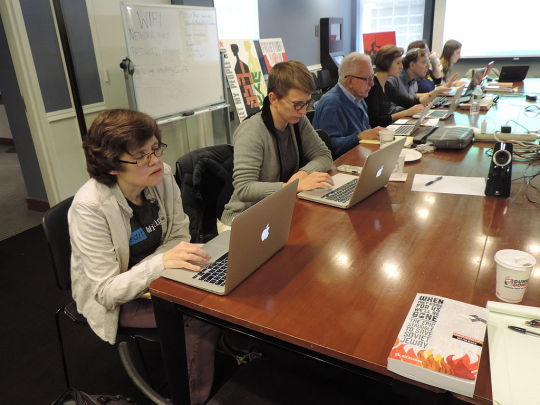By Leanora Lange

On a sunny Sunday in late fall, a quiet, cheerful, powerful event happened in one of the meeting rooms of the Center for Jewish History. A group of activists, archivists, and Wikipedians gathered around a large table, huddled over laptops, and improved coverage of the Soviet Jewry movement on the most widely accessed information resource in use today, Wikipedia.
The Soviet Jewry Wikipedia Edit-a-thon, hosted by the Center for Jewish History and the American Jewish Historical Society, was initially conceived as a celebration of the completion of a major digitization grant from the National Historic Preservation and Records Commission (NHPRC). This grant allowed Center archivists and digital lab staff to digitize over 75,100 images and over 500 hours of audio recordings from the American Jewish Historical Society’s Archives of the American Soviet Jewry Movement. This effort has made trip reports, photographs, posters, phone conversations with refuseniks, speeches, and ephemera (including pieces like phone numbers and addresses written on bubble gum wrappers—see items 197-202 in box 1 folder 2 of the Leslie Schaeffer Papers) openly available across the world via the Center’s central search and digital assets discovery systems.
Digitization is nothing without access. Access is nothing without spreading the word to potential users. This is where Wikipedia comes in.
Consistently among the ten most popular websites in the world (after Google, Yahoo, Facebook, YouTube, and such), and the most popular non-commercial website by far, Wikipedia is a central source of information in today’s age. Perhaps the most incredible thing about Wikipedia is that it functions on the good will of hundreds of thousands of volunteer editors.
At our edit-a-thon, two new editors were added and impressive ones at that: Lawrence Lerner and Glenn Richter, both leaders of national grassroots organizations in the Soviet Jewry movement (President of the Union of Councils and Co Founder of the Student Struggle for Soviet Jewry, respectively). Their presence brought not only expertise but a certain gravitas to our activities.
Over the course of our event, five new pages were created, twenty articles were improved, and several images were added to Wikimedia Commons. The new articles included Morey Schapira, Avital Sharansky, Pamela Cohen, and a Russian-language page for Jacob Birnbaum: ru:Джейкоб (Яков) Бирнбаум. See the Outcomes on the event page for a full list.
Beyond improving content on Wikipedia, this event was one of the precious times when those of us who work behind the scenes connect with those who created the records to begin with. Not only did archivists meet activists, one local Wikipedian introduced himself to the activists at the event as the son of one of their fellow activists from decades past. Somewhere between these types of personal relationships, the protest songs played in the background by one of the archivists, and the conversation between the activists about Wikipedia pages, the connection between communities, historical events, and those charged with collecting and making accessible that history was illuminated.
“History is not what happened. History is what is written,” said Mr. Richter. In this event, this group of activists, archivists, and Wikipedians nudged one of the most popular sources of the historical record just a little closer to reflecting what happened.
Leanora Lange is an archivist at the Center for Jewish History, where she chairs a committee of archivist-Wikipedians. She is also on the board of Wikimedia NYC.

